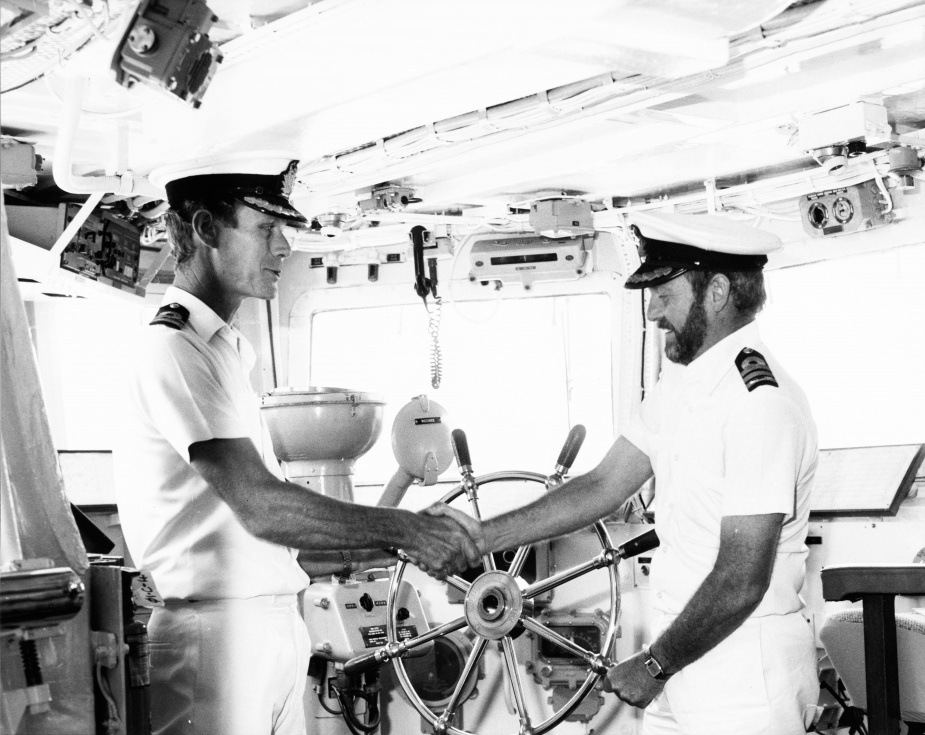HMAS Stuart (II)
| Class |
River Class |
|---|---|
| Type |
Destroyer Escort (formerly designated as Anti-submarine Frigate Type 12) |
| Pennant |
DE48 |
| International Callsign |
VKCK |
| Motto |
Semper Paratus - Be Prepared |
| Builder |
Cockatoo Docks and Engineering Company, Sydney |
| Laid Down |
20 March 1959 |
| Launched |
8 April 1961 |
| Launched by |
Mrs JG Gorton, wife of Minister for the Navy |
| Commissioned |
28 June 1963 |
| Decommissioned |
26 July 1991 |
| Dimensions & Displacement | |
| Displacement | 2700 tons, full load |
| Length | 112.8 metres |
| Beam | 12.5 metres |
| Draught | 5.5 metres |
| Performance | |
| Speed | 30 knots |
| Complement | |
| Crew | 234 |
| Propulsion | |
| Machinery | Remote controlled steam boilers and geared steam turbines (two shafts) |
| Horsepower | 30,000 |
| Armament | |
| Missiles |
|
| Guns | Turret of two 4.5-inch guns controlled by an M22 Fire Control Radar |
| Torpedoes | Two triple barrel anti-submarine torpedo tubes |
| Awards | |
| Inherited Battle Honours | |

The type 12 Anti-Submarine Frigate, HMAS Stuart, was the second ship to carry the name in the Royal Australian Navy. She was constructed at Cockatoo Island Dockyard, Sydney, and was launched on 8 April 1961 by Mrs JG Gorton, wife of the then Minister for the Navy. On the day of her launching Sydney Harbour was graced with a warm sunny day and a large crowd of over 4000 people was in attendance. She commissioned at Garden Island, Sydney on 28 June 1963 under the command of Commander Maurice L Molony, RAN.
After working up, Stuart commenced a series of tests and trials of the Australian developed Ikara missile system. Stuart was the first ship to be fitted with the weapon. This task continued to occupy the ship during 1964 and the first half of 1965. A refit followed from August to December 1965.
Following a series of post-refit trials, Stuart departed Sydney 30 May 1966 for Pearl Harbor, where she participated in exercises with the United States Navy. She then proceeded to the Far East, returning to Sydney on 17 January 1967.
In May 1967 Stuart rendezvoused with the troop carrier Sydney and escorted her into Vung Tau, South Vietnam. The ships returned to Australia together.
On 4 September 1967 Stuart departed Sydney for a tour of duty with the Far East Strategic Reserve. During this tour she again escorted Sydney into Vung Tau in February 1968.
Stuart returned to Sydney on 1 April 1968 and a week later proceeded to Melbourne to refit at Williamstown Dockyard. Following the refit she returned to Sydney on 2 October 1968 and during the next five months was mainly engaged in exercises and trials.
Departing Sydney on 22 March 1969, Stuart began another tour of duty with the Far East Strategic Reserve. It was during this tour that the ship was one of the Australian vessels participating in a SEATO exercise in the South China Sea, in the course of which the destroyer USS Frank E Evans sank with heavy loss of life after a collision with the aircraft carrier HMAS Melbourne. Stuart returned to Sydney on 13 October 1969.
A period of exercises followed. In April 1970 Stuart acted as escort to the Royal Yacht Britannia during the visit of Her Majesty the Queen to Australia.
A further tour of duty with the Far East Strategic Reserve began with Stuart's departure from Sydney on 11 May 1970 and ended with her return on 15 October 1970. Further exercises and trials followed.
On 19 April 1972 Stuart departed Sydney for deployment with the ANZUK Forces in the Far East, followed by a visit to Pearl Harbor in August/September 1972 for exercises with US, Canadian and other Australian Ships. She returned to Sydney on 6 October 1972.
Stuart remained in the Sydney area until August 1973 when she took part in RIMPAC exercises, returning in October 1973. In November 1973 she again left Australian waters, this time for Singapore to take part in Exercise SANDGROPER. She deployed to South East Asia in June 1974 and remained within the area until November that year. In December 1974 and January 1975 she participated in the relief of Darwin following Cyclone Tracy. Most of 1975 was spent in refit.
In June 1976 Stuart deployed in company with HMAS Vampire to the west coast of the United States and Canada as part of the American bicentenary celebrations. Ports visited included Pago Pago, Pearl Harbor, San Diego, San Francisco and Esquimalt. On her return to Australia she participated in Exercise KANGAROO II before carrying out a circumnavigation of Australia in company with HMA Ships Supply, Stalwart and Torrens.
Your INR performance was absolutely superb. The smartness of ships, the appearance and demeanour of crew were a matter of great personal pride to all. The enthusiasm, spirit, and total professionalism of all hands efforts made this observance one of those proud moments in our Navy - Marine Corps and Nation's history - Well done.
CINCLANTFLT Admiral Isaac Kidd, JR, USN





























